The Rise and Fall of a Mercantile Town: Family, Land and Capital in Newburgh, New York 1790-1844
by Mark C. Carnes
Editors Note: Posted with Permission from Professor Mark C. Carnes
A New Era
A new era has dawned; the tidal wave of prosperity that swept over the village a hundred years ago has returned. The old turnpikes have been paralleled with railroads, stretching to us from every direction; and the river, too, gives us communication with the Atlantic coast and all the world. Many manufactories are springing up within our bounds, and the year 1891 finds us the most thriving city on the Hudson, with citizens full of the spirit of pub li c enterprise, with public institutions comparatively unequalled, and with apparently every factor and requisite to ensure its bright future as a manufacturing and commercial city of importance.
-John J. Nutt, Newburgh-Her Institutions, Industries and leading Citizens (1891)
The city described by John Nutt towards the close of the 19th century had recently emerged from a mercantile tradition to become a small manufacturing center. Smokestacks creased a skyline that had once been the domain of boat masts and church steeples. Factory whistles quickened a pace of life formerly regulated by the subtle vagaries of season, wind and tide. Giant steam boilers, by expanding the applications of power, altered the dimensions of interpersonal space for thousands of factory workers whose fathers had endured the more solitary tasks of an earlier era. A new way of life, at once urban and industrial, had supplanted that of a mercantile village.
Such a portrait, as is the case with most historical generalizations, necessarily simplifies reality. The transition from mercantile village to manufacturing city was for the most part continuous, the distinction a matter of degree. Newburgh maintained some of its earlier functions as a commercial enterprise well into the late 1800s. But by 1891 the pulse of Newburgh’s economy ceased to be measured by the flow of traffic on the Hudson River; the stately homes of the resident freighters that lined the crest of hills above the city no longer reflected their dominance in the daily affairs of the community. The new era embraced a series of transformations: from sloop to railroad, from storehouse to factory, from merchant to manufacturer. 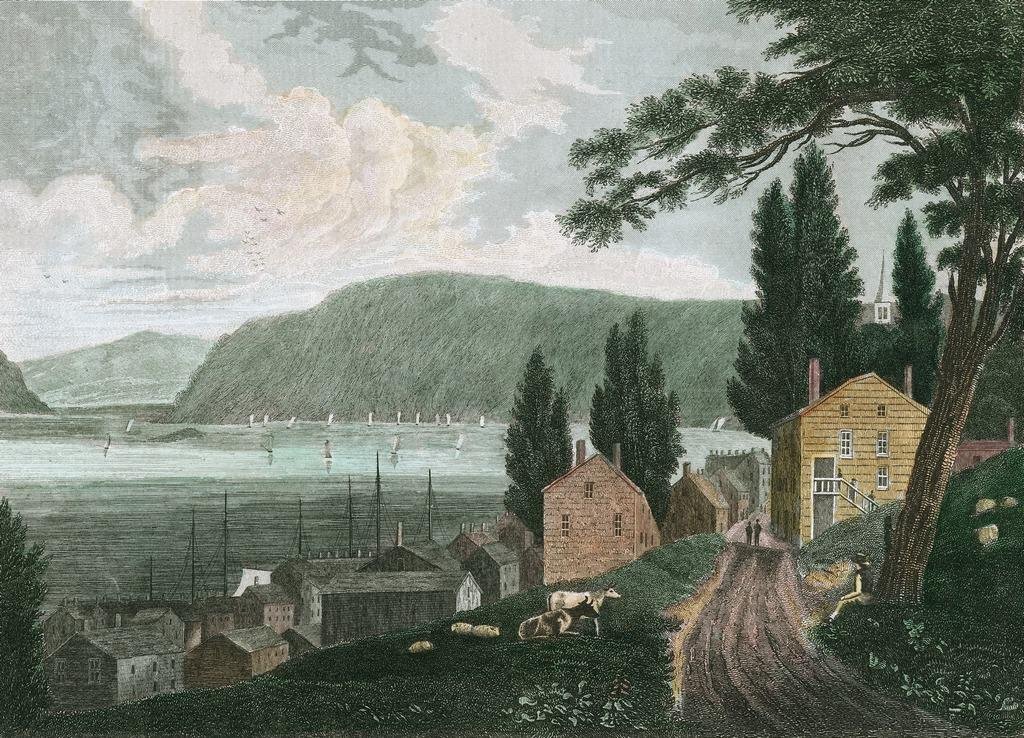
The consequences of the 19th century urban-industrial revolution have received the ample attention of the social sciences, giving rise in many cases to new disciplines and subdisciplines. But lost in the human drama associated with the problems of industrialization and urbanization is a clear perspective on the processes the themselves.1 That they are connected remains unchallenged. Historians of 19th century America unfailingly interrelate statistics on urban and industrial expansion while economists often explain economic change as a variation in the urban-rural two sector model.2 To point out a relationship, however, is not to describe a process. An understanding of either urbanization or industrialization requires an elucidation of the exact mechanisms that resulted in the dynamic fusion of both during the 19th century.
The economic basis for urban-industrial growth is not an unexplored subject, although the discussion has for the most part been confined to specialized branches of economics and geography. It is widely held that the 19th century city was the logical and perhaps inevitable product of certain economic forces. Industrial producers who located in cities quickly learned that an urban environment conferred a number of advantages, including an abundant supply of labor and managerial personnel, a nearness to markets and related producers, and access to informational and financial institutions. However, several questions remain unanswered. In the absence of industries, what initiated the process of urban-industrial growth? Why did some cities of comparable size grow more rapidly than others? And if industrialization had a major impact on urbanization, to what extent did the process of urban development influence the nature of industrialization?
Several models have been proposed to answer these questions, but there has been little consensus among urban scholars as to their merits. It is impossible to summarize the theoretical models here, but the main issues concern whether large or small cities were more conducive to early manufacturing,3 whether urban growth is best understood as the result of external or internal processes, and whether industrialization alone could be the driving force behind 19th century urbanization.4 Some theorists have summoned the cliometric muse to resolve these issues, but by their own admission the results have been inconclusive.5
For the theorist the problem is to find a set of data broad enough to support meaningful generalizations without aggregating materials reflecting disparate experiences. Simeon Crowther has observed the “weakness” of conclusions concerning 19th century urbanization based on national and regional data, claiming that “the level of aggregation may still be too high.” Crowther then examined a somewhat smaller region but was still surprised by the “idiosyncratic” nature of urban growth.6
The present study offers a more limited frame of reference: the experiences of one small city during the 19th century. Located sixty five miles north of New York City on the west bank of the Hudson River, Newburgh probably was similar to many small cities that underwent an evolution from a commercial to an industrial economy. While it remains to be seen whether the analysis that follows can be applied to other such cities,7 the insights provided by this approach compensate for its obvious limitations in applicability. In particular, it becomes possible to explore the role of the entrepreneur and of ideology-missing from the regression formulas of the cliometricians in the process of urban-industrial change.
The theme developed in the following pages is that Newburgh’s urban-industrial growth was not caused solely, or even most importantly, by external economic forces. Of equal significance were the emergence of a cohesive class of entrepreneurs and the proliferation of an ideology of localism (defined here as the parochial attraction of an individual to his current place of residence), both of which marshalled capital into urban growth. Although changing market forces established the constraints under which Newburgh’s economic structure was to operate, the local response to these forces was neither predictable nor even comprehensible from the standpoint of conventional economic precepts.
Newburgh’s development during the 19th century was of little intrinsic significance; it may therefore seem an implausible subject for a case study in the process of urbanization. As John Nutt understood, however, the important point is not that Newburgh failed to become a major industrial city, but that it achieved as much as it did.
A Business Place, 1790-1841
What is Newburgh? What is its distinguishing Trait? It is truly a business place. Since its origins to the present moment it has received and sustained that character. There is no place within the bounds of our knowledge, of which so large a proportion of the inhabitants are business men. Within its limits are about 200 buildings opened for the purpose of carrying on some mercantile pursuit, or for engaging in some public transaction with the community, employing at least 1,000 persons.
-Newburgh Gazette, May 30, 1835
The editor of the Newburgh Gazette erred in claiming mercantile origins for his town. In 1765 Newburgh was a farming hamlet of but seventeen houses and a number of lesser structures; the town was never destined to commercial greatness. Even the town’s beginnings were unpromising: the instrument of its creation – a 1718 patent granting a large tract of land to Lutherans from the Palatinate became the source of a protracted religious controversy as a growing settlement of Anglicans began to contest ownership of a large section of town lands known as the Glebe. In 1751 the English governor exacerbated religious tensions by rescinding the Lutheran patent and awarding the Glebe lands to the local parish of the Church of England. With the coming of the War for Independence religious rancor became superseded by an even more intense political struggle between loyalists and rebels. 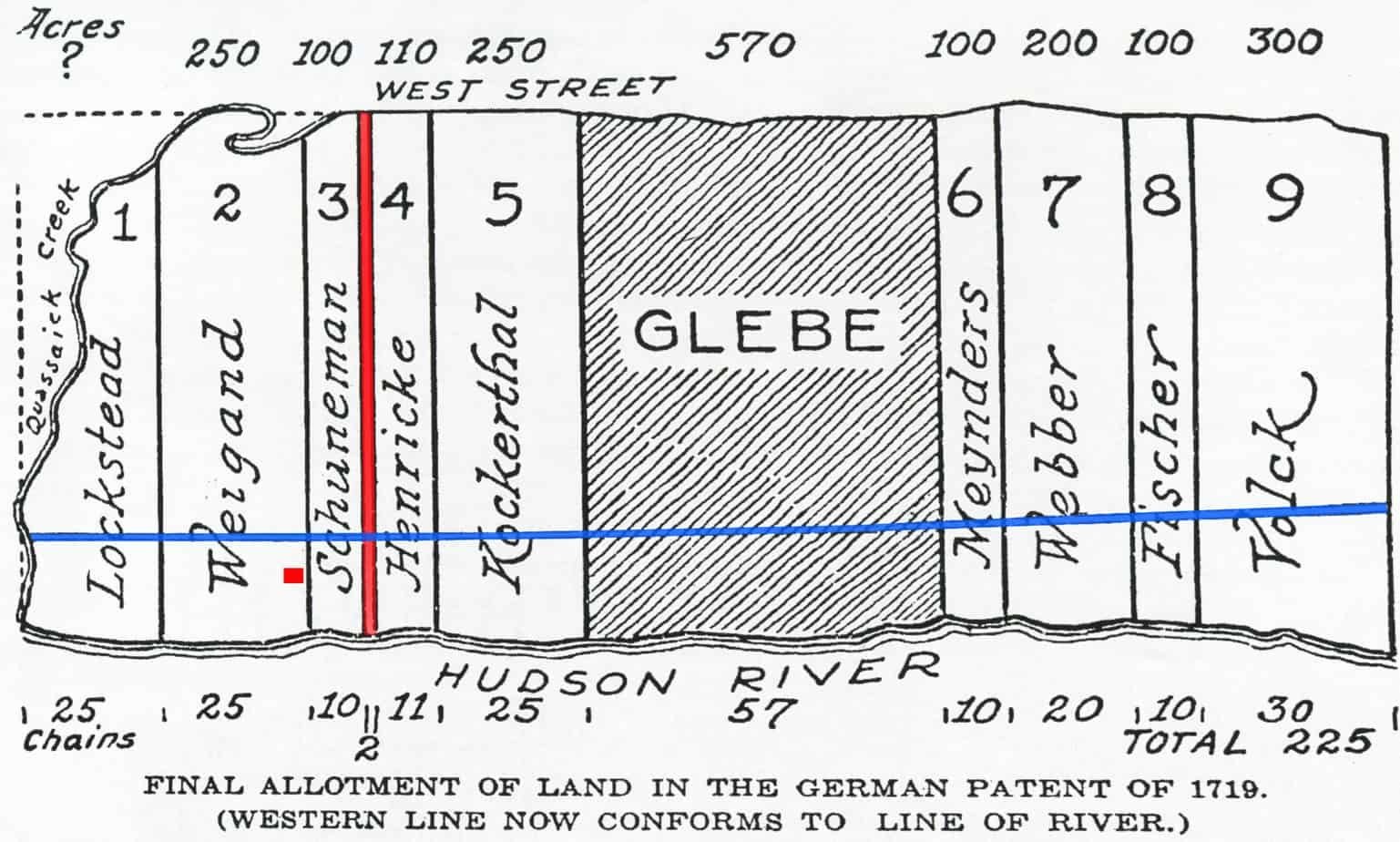
The only interruption in the local historians’ chronicles of the 18th century internal strife was the happier story of Newburgh’s being chosen as General Washington’s main bailiwick during the closing years of the war. But if the war provided the town with a claim to distinction, it also brought civilian refugees from New York City, and soldiers without food or housing, who carried only worthless military scrip. By the end of the war Newburgh’s economy was “so poor indeed” that special legislative aid was sought and given in 1785.8 Factious, impoverished, and lacking the institutions that might have provided a sense of purpose or community, Newburgh did not seem destined to attain commercial importance.
But if the Gazette’s editor had mistaken the nature of the town’s origins, his description in 1835 of a growing and prosperous mercantile village was substantially correct. Not yet a city (a charter was still thirty years away), Newburgh quadrupled in population between 1790 and 1840 reaching 6,000 by the later date. Each season an estimated 84,000 farmers from the interior of Orange County brought great tubs of butter, pork and milk along turnpikes to docks and storehouses lining the Hudson at Newburgh Bay. Newburgh’s freighters (usually called forwarding merchants) seasonally sent nearly five million dollars of produce to wholesalers in New York City, and their boats returned with clothing, farm implements and other articles to be sold to the town’s residents and visiting farmers. A rapidly growing colony of shoemakers, blacksmiths, tailors, chandlers, and shopkeepers fulfilled the remaining needs of the populace. No longer an impoverished and insignificant farming village, Newburgh had become “a shipping point of consequence.” 9
Newburgh’s unexpected development as a prosperous commercial village was caused by the interplay of external and internal factors in proportions difficult to determine. Central among these factors was the emergence of a closely-knit group of entrepreneurs. Without these men and the attitudes they fostered towards Newburgh, the bustling mercantile village of 1840 would have been inconceivable. To avoid overemphasizing these and other internal influences, however, it is best to keep in mind the role of forces external to Newburgh itself.
After all, Newburgh’s development was not unique, but part of the overall economic and demographic transformation of the Northeast during the half-century after 1790. The impetus for change originated in Europe where the economic disruptions of the Napoleonic Wars aggravated what had already become a chronic food shortage. Increasing European demand led to higher prices for American foodstuffs; within several years farmers in New York and Pennsylvania with access to export markets shifted from a system of diversified crops for home consumption to one of intensive cultivation of cash crops, predominantly cereals, for export.10 Such a transition occurred in Orange County and the adjacent regions to the west as farmers began to specialize in wheat production. Newburgh became a center for the collection and reshipment of their wheat.
Coincident with the rise of commercial agriculture in Orange County was the arrival of enterprising farmers from New England. Discouraged by the thin and unproductive soils of New England, hundreds of thousands of Yankee farmers migrated to the New York frontier after the Revolutionary War.11 They prized especially the land west of the Hudson, including Orange County, where the freehold prevailed in contrast to the manorial land-tenure system in the counties to the east.12 Fierce critics of the proverbial lethargy of the native New Yorkers, the Yankee farmers recognized the potential arising from external demand and were in large part responsible for the region’s transition to commercial agriculture.13
Yankee merchants and townspeople followed these farmers westward. Whalers from Nantucket founded the town of Hudson, New York in 1783 while Boston “adventurers” established Troy in 1787.14 By the turn of the century a “mighty invasion” of Yankee business and maritime talent to New York City had “swamped” the established, Knickerbocker merchants.15 Newburgh, likewise, felt the effect of Yankee enterprise. Prior to the “invasion” of New England entrepreneurs, Newburgh’s forwarding trade was conducted in a leisurely manner. Several of the area’s older patriarchs, including Isaac Belknap, Robert Ludlow and Hugh Walsh, operated a few sloops with no particular schedule. But with the coming of the Powells, Carpenters, Reeves, Coffins and Ramsdells – all New Englanders – the forwarding business underwent a significant change.16 The freighters now adopted schedules, advertised in local newspapers, and extended credit to area farmers, all of which were indicative of a more aggressive search for business.
In the 1820s and 1830s, however, farmers and shippers throughout the mid-Atlantic perceived that the region’s grain production was faltering. The intensive cultivation of wheat had exhausted the soil while a variety of crop diseases and infestations-including rust, Hessian fly and grain worm-further narrowed the farmer’s profit margins.17 The Erie Canal, completed in 1825, reduced long-distance freight rates and grain from the Old Northwest soon flooded the eastern seaports. Confronted with the higher yields and lower production costs of the fertile soils and large farms of Ohio, Indiana and Illinois, the grain farmers of New York and Pennsylvania could no longer successfully compete for eastern markets. 18
In many areas of the mid-Atlantic this competition precipitated an exodus of grain farmers to points further west, but in others (including Orange County) a new demand-the growing cities of the east initiated an era of agricultural prosperity. From 1790 to 1840 New York City’s population increased ten-fold, swelling the demand for milk, butter and other perishables that could only be supplied by farms near the city. Farmers in Orange County shifted from grain to dairy farming and became major suppliers of the New York City market.19 The prosperity of the agricultural hinterlands benefited Newburgh itself as the sloops and steamboats which had carried wheat and other cereals now were loaded with butter and milk.
Although Newburgh’s commercial development was made possible by external factors, such as the foreign and later urban demand for local agricultural products and the infusion of Yankee entrepreneurs, outside forces alone did not account for the town’s growth. Nor was Newburgh’s advantageous harbor location on the west bank of the Hudson River solely responsible for its success in exploiting the demand for the region’s produce. New Windsor, a neighboring town of comparable size and assets in the 1790s, failed to keep pace with Newburgh during the first half of the 19th century.20 How, then, did Newburgh come to monopolize the region’s forwarding trade?
Towards the close of the 18th century the arrival of ambitious New England merchants threatened to further divide a factious community, but competition yielded to an awareness of common purpose as the town’s forwarding merchants – old and new – coalesced into an informal group to advance their interests. They avoided price competition (the newspaper advertisements for the freighting firms emphasized advantages in marketing or handling, but never listed freight rates), maximized credit resources by entering into trading partnerships, and jointly embarked on expensive internal improvements. All redounded to their mutual benefit.
To the historian the advantages of mercantile cooperation may seem self-evident, but often these advantages eluded the provincial businessmen of the late 18th century. Although merchants were willing to enter into temporary partnerships or to pool funds for specific projects, they had difficulty forming enduring business alliances. Newburgh’s forwarding merchants solved this problem (as they would future problems) by imitating their New England forebears who found it expedient to unite mercantile families through marriage.21 Intermarriage not only encouraged mercantile cooperation, but it also strengthened the capital reserves of the family firms. And in the absence of formal economic organizations such as banks and insurance companies, the maintenance of adequate capital for investment and trading was essential.22 Accordingly, three of Newburgh’s most important freighting families – the Belknaps, Crawfords and Carpenters – became joined as the two daughters of Isaac Belknap, Jr. married the sons of Francis Crawford and Benjamin Carpenter. Similarly, the main freighter of the nearby town of Cornwall, Isaac Van Duzer, married the daughter of Selah Reeve, an important Newburgh forwarding merchant, while Reeve ‘s son married Van Duzer’s niece. Another prominent freighter, William Walsh, became aligned to the Van Duzer-Reeve families by marrying the daughter of Isaac Van Duzer and Katurah Reeve. These and other mercantile intermarriages (see Figures l and 2) often transcended differences in religion and length of residence. Mercantile intermarriages, engendered by the need for capital and stable business relationships, created the formal ties which bound together Newburgh’s mercantile community.


The earliest of the freighters’ cooperative endeavors was the construction of turnpikes into the agricultural hinterlands to the west. The lack of decent highways had circumscribed the merchants’ efforts to supply the demand for the region’s produce, since freighters found it unprofitable to carry their crops further than twenty miles over unimproved roads.23 Therefore, in 1801 a group of freighters that included Powell, Walsh, John McAuley and several others, built a turnpike that extended from Newburgh nearly sixty miles west to the town of Cochecton. Although the turnpike company lost money, the road conferred “immense advantages” on Newburgh and its forwarding merchants by enabling farmers from a wide area to bring their produce to the town. The Newburgh and Cochecton Turnpike was followed by others to New Windsor in 1806 and to Plattekill in 1810 (see Map I). By 1819 turnpikes radiated from Newburgh through much of the southern tier of New York State. The Bank of Newburgh established a branch office in Ithaca in 1820 and within several months Newburghers were subscribing to operate a steamboat on Lake Cayuga. Through the efforts of the forwarding merchants, Newburgh had become the “shortest and most expeditious route from the Hudson River to the western country.”24

Newburgh’s freighters, often dependent on New York City credit sources, also shared the goal of financial independence and pursued it collectively. Powell, Reeve, Carpenter, Crawford and Belknap, among others, snatched the opportunity provided by the expiration of the Bank of the United States in February, 1811 and the less restrictive banking rules that followed. In March of that year they established the Bank of Newburgh.25
A final example of the spirit of cooperation that prevailed among the forwarding merchants can be found in their response to the challenge of steam-powered navigation. Until the Fulton-Livingston steamboat monopoly on the Hudson expired in 1825, Newburgh’s forwarding trade was carried on sloops. The availability of steam transportation signaled an era of competition among Newburgh’s freighters. The forwarding merchants called a meeting in June, 1825, to discuss the situation. After appointing a committee to study the matter of “building a good and efficient steamboat or boats,” the merchants agreed to postpone the modernization of their fleets for five years. In this way they avoided the expense of a premature and costly conversion to steam. 26
Although intermarriage guaranteed the cohesiveness of Newburgh’s economic elite, it did not ensure an identification of the needs of the elite with those of Newburgh. And Newburgh would have gained little if the forwarding merchants had decided to move elsewhere (as was often the case in the Northeast during the 18th century). But they stayed and worked to improve the town’s economic foundations, even during the hard times caused by the Embargo of 1808 and the War of 1812. Their perseverance was all the more remarkable since most of the freighters were themselves newcomers. William Walsh, for example, originally established his freighting trade in New Windsor, but upon his removal to Newburgh became a diligent promoter of that town’s interests, serving as president and trustee of the village and advancing the funds for the first secondary school. Indeed, the two men most identified with Newburgh’s development during the 1800s – Thomas Powell and his son-in-law Homer Ramsdell – came to Newburgh in their thirties. The steadfast affiliation of the forwarding merchants to the town cannot be explained by ancestral bonds or provincial traditions. Rather, the spirit of localism in 19th century Newburgh was rooted in the land.
Real estate considerations influenced much of Newburgh’s history: the struggle over ownership of the Glebe lands during the 18th century foreshadowed the even more important role of land ownership in the town’s development a century later. As mercantile profits mounted during the second and third decades of the 1800s, the forwarding merchants sought new investment opportumt1es. Since their mercantile activities were somewhat risky, the freighters desired security rather than high profits in their non-mercantile investments; stable assets could serve as collateral or reserve capital in the event of a financial crisis or boat accident (there were several of each). Local real estate-secure, inexpensive, and likely to appreciate – suited their investment needs. Furthermore, land ownership seemed consonant with the forwarding merchant’s newfound social standing in the community. 27
By 1835 the freighters owned a large portion of Newburgh. In addition to the stores, wharves and warehouses used in the forwarding trade, some merchants, including the Walshes, Carpenters, and David Crawford, had built hotels near the waterfront. Others, including Powell, Van Duzer, Reeve, Smith, Henry Robinson and Henry Walsh (William’s brother and mercantile successor), had purchased large tracts of farmland in the southern and western sections of the village (refer to Map 2). These expansive estates (Robinson’s covered nearly three hundred acres) girdled the densely populated section of the village, a twenty-nine-block section loosely bounded by the Hudson River, Western Avenue, Liberty Street, and South Street.

Although the forwarding merchants originally invested in local real estate for security, they quickly learned that sizeable profits could be achieved through the growth of the town. A two-acre lot between Grand and Liberty Streets that had been purchased for eight hundred dollars in 1833 sold for four thousand dollars two years later. The key to real estate profits was the extraordinary price differential between the intensely used commercial and residential properties in the center of the village and the farmlands and estates of the freighters towards the periphery. The steep decline in land prices as one moved away from the riverfront is indicated in Table 1; vacant lots along the riverfront sold for three hundred dollars per foot while lots located just five or six blocks away were sold for eight to twenty dollars per square foot. The farmlands purchased by the for warding merchants were sold by the acre for what amounted to less than a dollar per frontage foot. Should Newburgh’s population continue to increase, the demand for land near the center of the village would drive up the price of the forwarding merchants’ estates.
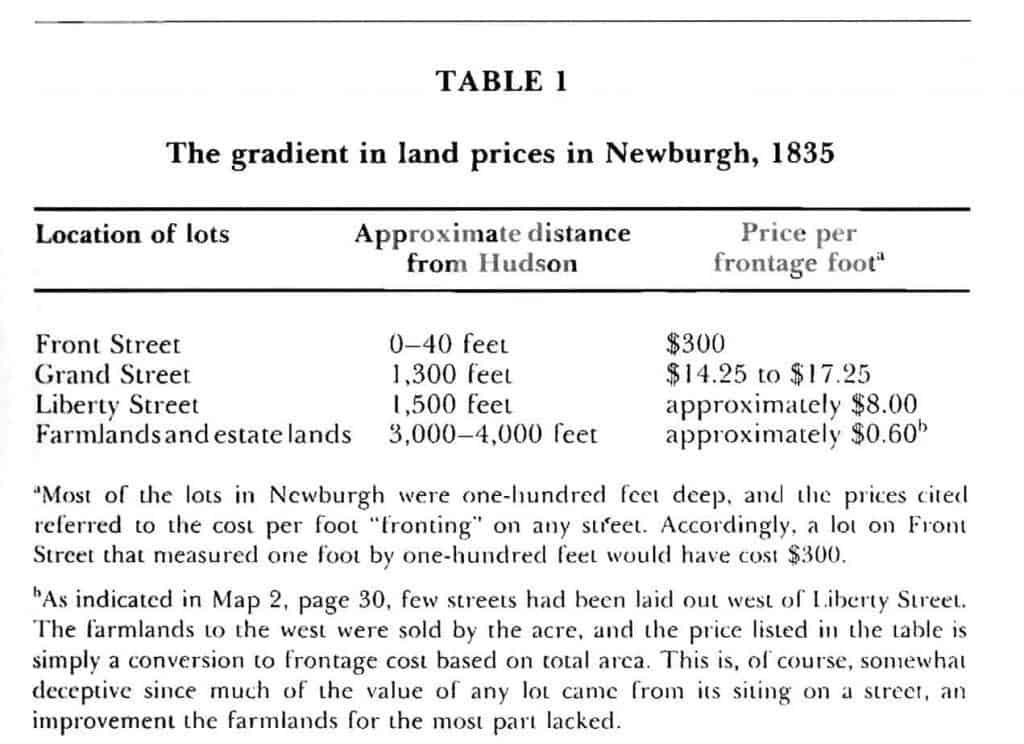
The long-term effects of the freighters’ real estate investments are considered later in this essay, but there was one immediate consequence of their landholdings: the forwarding merchants became rooted to Newburgh. If the town grew, their stores, hotels and landed estates would appreciate in value; if it failed their properties would become relatively worthless. They found it necessary, therefore, to watch over the interests of the town as well as their own businesses, for the two had become inseparable.
Thus, the spirit of cooperation and collective guidance – formalized through intermarriage – interacted with the parochial attachment of the freighters towards Newburgh. Through this combination of cohesive entrepreneurship and localism, Newburgh outdistanced its 18th century commercial rival – New Windsor, which was beset with divisiveness and jealousy among the resident freighters. One observer concluded that this factionalism “dried up the springs of action which impel communities to undertakings in which mutual prosperity is involved. From their presence enterprise and the enterprising fled away.”28
In 1840 Newburgh’s future as a major commercial center, was assured. New York City was rapidly becoming one of the largest cities in the world and the prospect for an ever-increasing demand for local foodstuffs buoyed Newburgh’s forwarding merchants. Under their guidance, Newburgh was destined to become a business place of even greater significance. Or so it seemed.
A Continued Sabbath, 1842-1845
What has been experienced in Newburgh by the opening of the Erie railroad? Rents have fallen 50 per cent; two thirds of their steam boat passengers have gone; their hotels are empty and everything indicates the approach of desolation and ruin!
Speech given in Poughkeepsie as reported in the Newburgh Journal, March 12, 1842
Such were the deadening influences of the construction of this road that it prostrated the businesses of Newburgh-houses were tenantless, men shut up their shops and removed to more favorable localities, and the whole trade of the mechanical arts stood still with it. The effect was blighting in the extreme, and the streets were empty as if it were a continued Sabbath.
Samuel Eager, An Outline History of Orange County (1846)
The urban biographers of the nineteenth century resorted to a recurring metaphorical imagery to explain the growth of their cities: although an aggregation of many peoples, a city was itself a person, with collective human goals and attributes. The rapidly growing city was “vigorous” or “energetic”; that with limited prospects was “somnolent” or “sleepy” – as if a loud noise could startle it into a more prosperous or expansive state. The metaphor suggested coherence and unity: a mass of people striving or stumbling as one towards a common goal. For the individual as well as the city, that goal was progress, and progress was measured in numerical terms: how big, how much, how many.
But the usefulness of the metaphor fades when exposed to historical scrutiny. The nineteenth-century city was not a functional unity, but a heterogeneous aggregation of transients who boiled rather than blended in the urban melting pot. If the rewards of the economic system were unevenly distributed, so were the aspirations and expectations of the participants. And if progress was commonly defined in quantitative economic terms, few people were willing to bridge the metaphorical gap between their personal goals and the elusive collective goals of a particular city. Some people, however, encountered no such obstacle. Their aspirations for personal wealth were consonant with and dependent on the growth of a city.
Newburgh’s forwarding merchants were such men. In pursuit of profit they created a city; they left it to a later generation of city historians to rearrange the causal sequence. The merchants constructed the wharves and turnpikes, erected the stores and warehouses, and established the institutions and personal fortunes that became the economic foundation of the city. As the agricultural hinterland expanded and prospered, so, too, did Newburgh. The freighters, moreover, quickly responded to the financial opportunities that arose from internal growth. By the 1830s their fortunes were inextricably tied to those of Newburgh.
But the Erie Canal, completed in 1825, severed Newburgh’s western hinterlands, as the farmers of the Finger Lake region chose to take their produce north to the canal rather than east to Newburgh. The Ithaca branch of the Bank of Newburgh closed shortly after the opening of the canal, and Newburgh’s prospects for becoming the eastern terminus – via turnpike – for the trade with the Old Northwest evaporated.
In 1828 the completion of the Delaware and Hudson Canal further constricted Newburgh’s hinterland. Following the contour of the Shawangunk mountains northeast to Kingston, the Delaware and Hudson provided a Hudson River outlet for the coal of eastern Pennsylvania. Although Newburgh’s forwarding merchants resignedly accepted the success of the Erie Canal, they immediately made plans “to counteract the detrimental effect” of the Delaware and Hudson Canal. Thomas Powell, David Crawford, Christopher Reeve (Selah’s son), William Walsh and several others received a charter in April, 1830 to build a railroad from Newburgh to the Delaware.30 The plans to construct a railway to the west proved unnecessary. Few Orange County farmers sent their produce to market via the Delaware and Hudson Canal.31 Moreover, high agricultural prices and the successful transition from cereal cultivation to dairy farming marked a period of sustained agricultural prosperity in Orange County during the 1830s.32 This business, Newburgh’s freighters soon realized, more than compensated for the loss of the western hinterlands; from 1830 to 1840 Newburgh’s population increased from 3,800 to 6,000.
During the decade Newburgh’s merchants were disconcerted over rumors of a major railroad extending through the southern tier of New York.33 Designed to link New York City with Buffalo and markets further west, such an undertaking would necessarily pass through Orange County, potentially disrupting Newburgh’s turnpike-based transportation network. The freighters’ fears were soon confirmed. In December, 1831 several of the most prominent farmers and businessmen of the central and western sections of Orange County attended a meeting in support of the proposed railroad, and some volunteered to serve on a committee of correspondence to draft legislation to further those ends.34 In 1832 the New York State Legislature chartered the New York and Erie Railroad, fixing its capital at ten million dollars. Listed among its incorporators were important farmers and businessmen throughout the southern tier as well as several formidable New York City merchants.
Despite these connections, however, the Erie Railroad had difficulty raising the large sum of money required in the charter. Businessmen were well aware that the railroad was developmental in nature and avoided heavy commitments to the enterprise. An initial survey reported that Goshen (twenty-two miles west of Newburgh), with a population of five hundred, was the largest town the railroad was to pass through. The terrain was difficult, the grades steep, and the railroad would have to compete with the enormously successful Erie Canal for through-traffic to the west. Under these conditions, few capitalists were willing to invest in the Erie Railroad.35
Legislatures, however, often find it difficult to reseal pork barrels. Arguing that the southern tier counties had been neglected by the State, the proponents of the Erie Railroad demanded public funds for internal improvements in that region. In April, 1836 the New York State Legislature authorized the acquisition of three million dollars of Erie Railroad stock. Although the stock purchases were initially contingent upon the completion of specified sections of track, subsequent legislation liberalized the terms of sale.36
During the same session of the legislature, Newburgh’s forwarding merchants renewed the long-dormant charter of the Hudson and Delaware Railroad Company.37 Their ostensible purpose was to compete with the Erie Railroad which, as expected, announced plans to lay track through the central and western portions of Orange County. By bisecting the agricultural heartland of the county, the Erie would disrupt the forwarding merchants’ trade (see Map 3). This could not be allowed.
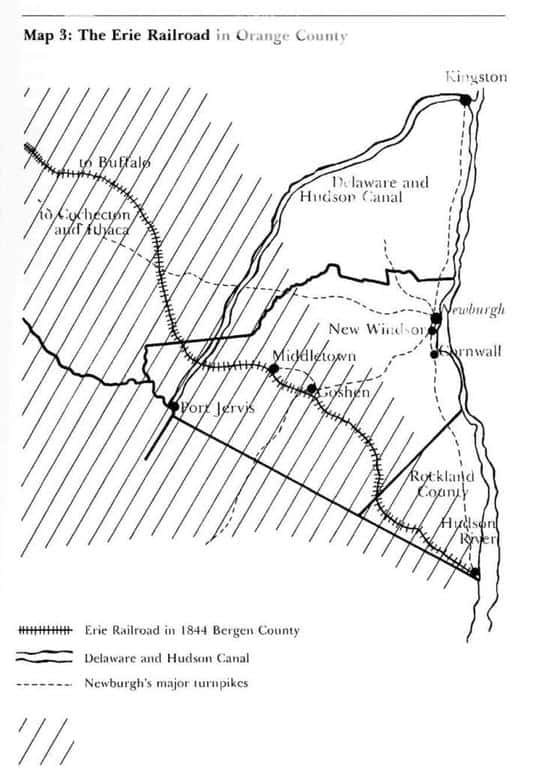
In 1837 a majority faction of the trustees of the Village of Newburgh (which included Benjamin Carpenter, David Crawford and Christopher Reeve) voted public monies to fund the Hudson and Delaware Railroad. The following year Newburgh allocated $150,000 for purchase of railroad stock and spent an initial $10,000 to survey the best route.38 But the funding was insufficient, the proposal ill-conceived. Newburgh’s freighters failed to halt the Erie. It began to lay track in 1838 and by the fall of 1841 track stretched from New York City to Goshen. The first train that departed from Goshen carried 44,600 pounds of butter, 16,000 pounds of pork and 1,500 pounds of leather. The editor of the Goshen newspaper immediately hailed the railroad a success – a realization of “the brightest anticipations of those who have watched over this work from its inception.”39 The farmers of central Orange County called for a second track, noting that even the “spirited exertions” of the railway were inadequate to handle existing demand. During its first three months of operation the Erie carried 5,900,000 pounds of freight, predominantly butter and pork, from Goshen to New York City with nearly equivalent tonnage on the return trips. Nearly 12,000 passengers traversed the route as well.’40 Furthermore, the railroad brought about the rapid growth of the formerly insignificant towns of Goshen, Chester, Middletown and Port Jervis:”41
The gain of the villages in the central and western portions of Orange County was Newburgh’s loss: the effect of the Erie Railroad on the town’s forwarding business was calamitous. Steamboat freight traffic declined by fifty percent, passenger traffic by nearly twothirds.42 In newspaper advertisements Newburgh’s freighters re minded the farmers of Orange County of “past favors” and pleaded for a “continuance” of their business. 43 One Newburgh freighter moved to Goshen to act as a marketing agent for agricultural produce shipped on the railroad.44 After the first “autumn of the Erie, ” the Newburgh Gazette outlined a dismal future for Newburgh.
If the Erie Railroad continues to do the business that it has done this fall, the business of Newburgh will not support more than half its present business men, half our freighting establishments will be needed, half the merchants will leave the place, half the stores will empty, half the dwellings will remain unoccupied.45
Change, however, is seldom as dramatic as historians – or newspaper editors-tend to make it. One year after the Erie Railroad began operation, the Newburgh Journal reported that “wagons from the remote districts of old Orange and from New Jersey, heavily loaded with firkins and tubs of butter, have come by the dozens into our village. Thus, it seems, many prefer the old channels of trade.”46 While the statement attests to the importance of the credit and marketing services of Newburgh’s forwarding merchants, it is equally significant that Newburgh’s freighting was already regarded as an “old channel of trade.”46
More to the point was an editorial entitled “The Poor – The Railroad” which proposed Newburgh’s first system of public charity to counteract the effects of “the general stagnation of business of all kinds.”47 By February, 1843 it became apparent that the impact of the Erie Railroad on Newburgh’s economy, was not temporary.48 From 1840 to 1845, Newburgh’s population declined; shops were closed, freighting lines discontinued, and real estate values plummeted.49
The people of Newburgh correctly attributed the town’s economic difficulties to the Erie Railroad. They reasoned, less cogently, that rail connections would restore prosperity, and the following decade was marked by efforts to convince railroads to run their tracks through the town. But the railroad agitation obscured a more fundamental and intractable problem. From 1790 to 1840 Newburgh had grown because it was located at a juncture between wagon and water transportation. But the Erie Railroad, which directly connected the agricultural areas of the county to New York City markets, made Newburgh superfluous. A rail connection from Goshen (or anywhere else in the center of the county) to Newburgh added ten to thirty miles plus a transfer cost to the trip. In short, the forwarding trade from Newburgh constituted the most costly and expendable leg of a competitive triangular trade. Newburgh’s future as a commercial center – a business place – was nonexistent.
For most of its residents, Newburgh’s economic collapse signaled yet another migration in search of an elusive if not illusory opportunity for steady employment. But the forwarding merchants could abandon the town only at great financial loss. They decided instead to create a new city.


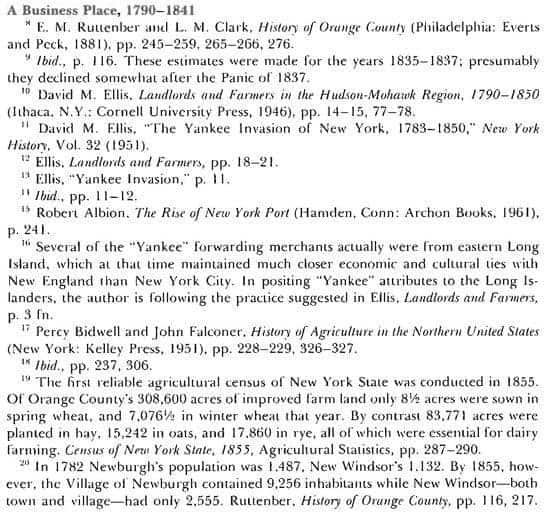
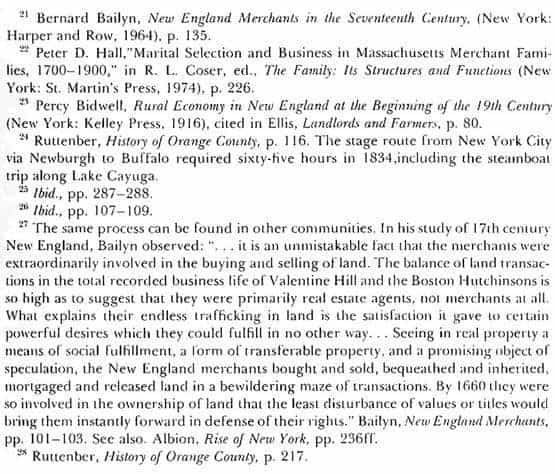
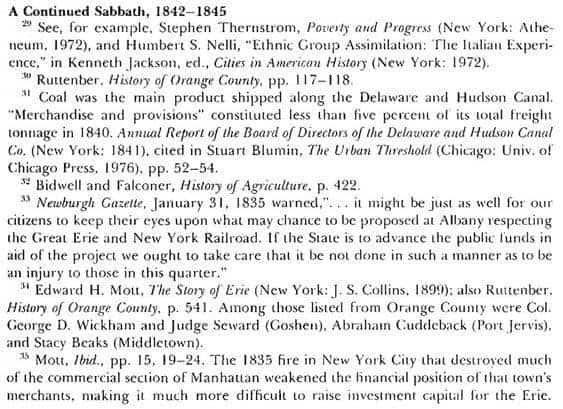

The Newburgh History Blog would like to extend a very special Thank You to Professor Carnes for allowing us to post this incredible look into Newburgh’s Past. This is part of a series. The next installment: “From Merchant to Manufacturer: The Economics of Localism in Newburgh, N ew York, 1845-1900” will be posted in the very near future.
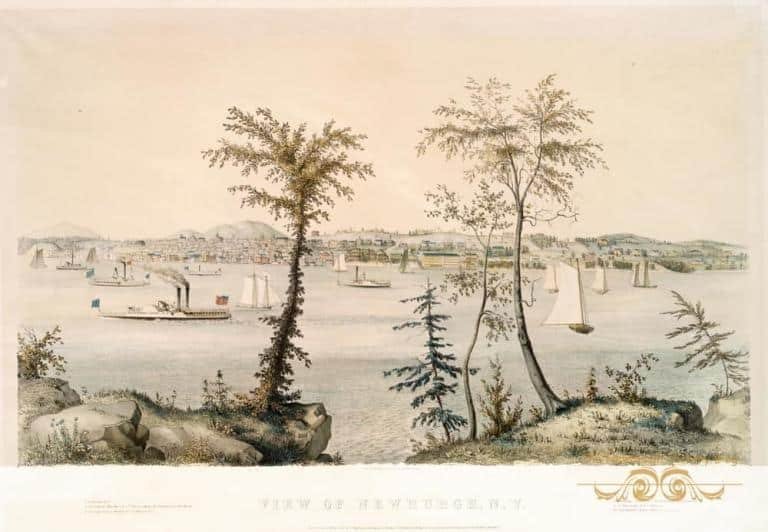
1 thought on “The Rise and Fall of a Mercantile Town: Family, Land and Capital in Newburgh, New York 1790-1844 (Part 1), by Mark C. Carnes”
Pingback: Discover Newburgh's East End Historic District